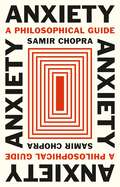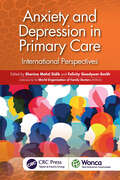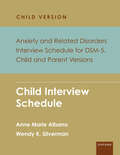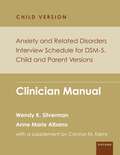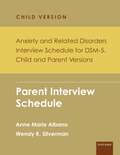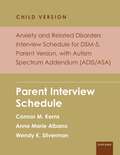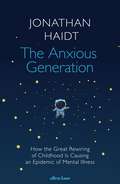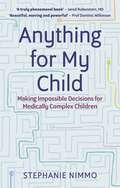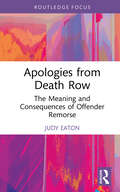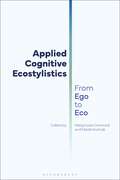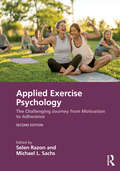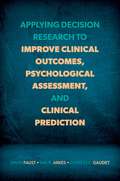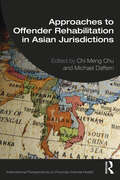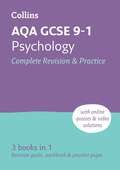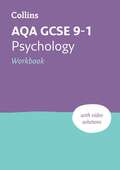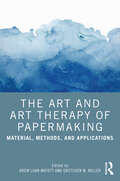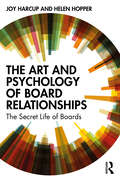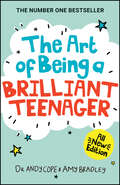- Table View
- List View
Anxiety: A Philosophical Guide
by Samir ChopraHow philosophy can teach us to be less anxious about being anxious by understanding that it&’s an essential part of being humanToday, anxiety is usually thought of as a pathology, the most diagnosed and medicated of all psychological disorders. But anxiety isn&’t always or only a medical condition. Indeed, many philosophers argue that anxiety is a normal, even essential, part of being human, and that coming to terms with this fact is potentially transformative, allowing us to live more meaningful lives by giving us a richer understanding of ourselves. In Anxiety, Samir Chopra explores valuable insights about anxiety offered by ancient and modern philosophies—Buddhism, existentialism, psychoanalysis, and critical theory. Blending memoir and philosophy, he also tells how serious anxiety has affected his own life—and how philosophy has helped him cope with it.Chopra shows that many philosophers—including the Buddha, Kierkegaard, Nietzsche, Freud, and Heidegger—have viewed anxiety as an inevitable human response to existence: to be is to be anxious. Drawing on Karl Marx and Herbert Marcuse, Chopra examines how poverty and other material conditions can make anxiety worse, but he emphasizes that not even the rich can escape it. Nor can the medicated. Inseparable from the human condition, anxiety is indispensable for grasping it. Philosophy may not be able to cure anxiety but, by leading us to greater self-knowledge and self-acceptance, it may be able to make us less anxious about being anxious.Personal, poignant, and hopeful, Anxiety is a book for anyone who is curious about rethinking anxiety and learning why it might be a source not only of suffering but of insight.
Anxiety: A Philosophical Guide (Moral Psychology Of The Emotions Ser.)
by Samir ChopraHow philosophy can teach us to be less anxious about being anxious by understanding that it&’s an essential part of being humanToday, anxiety is usually thought of as a pathology, the most diagnosed and medicated of all psychological disorders. But anxiety isn&’t always or only a medical condition. Indeed, many philosophers argue that anxiety is a normal, even essential, part of being human, and that coming to terms with this fact is potentially transformative, allowing us to live more meaningful lives by giving us a richer understanding of ourselves. In Anxiety, Samir Chopra explores valuable insights about anxiety offered by ancient and modern philosophies—Buddhism, existentialism, psychoanalysis, and critical theory. Blending memoir and philosophy, he also tells how serious anxiety has affected his own life—and how philosophy has helped him cope with it.Chopra shows that many philosophers—including the Buddha, Kierkegaard, Nietzsche, Freud, and Heidegger—have viewed anxiety as an inevitable human response to existence: to be is to be anxious. Drawing on Karl Marx and Herbert Marcuse, Chopra examines how poverty and other material conditions can make anxiety worse, but he emphasizes that not even the rich can escape it. Nor can the medicated. Inseparable from the human condition, anxiety is indispensable for grasping it. Philosophy may not be able to cure anxiety but, by leading us to greater self-knowledge and self-acceptance, it may be able to make us less anxious about being anxious.Personal, poignant, and hopeful, Anxiety is a book for anyone who is curious about rethinking anxiety and learning why it might be a source not only of suffering but of insight.
Anxiety and Depression in Primary Care: International Perspectives (WONCA Family Medicine)
by Sherina Mohd Sidik Felicity Goodyear-SmithThis book provides practical information about depression and anxiety in primary care, with a focus on the approach in different countries and incorporating global ranges/prevalence, risk factors and health burden including that associated with COVID-19 and its pandemic. To ensure the challenges of a wide international primary care community are reflected fully, authors from different world regions – Africa, Asia Pacific, East Mediterranean, Europe, IberoAmericana-CIMF, North America and South Asia – have co-contributed to individual chapters on the detection and management of depression and anxiety in primary care in their own countries, including the screening tools used, how widely these tools are adopted and by whom, and current policies. As well as the medical model, it also presents the alternative viewpoint that feeling low or anxious is part of the human condition and the attention should be on supporting people in their journey through life, struggling to deal with the mainly social challenges they meet, rather than defining these problems as disorders or diseases requiring identification and treatment. Key Features: Explores the instruments used for the detection of depression and anxiety in primary care in various countries, and why and how these instruments are being used Describes the pharmaceutical and non-drug interventions for treating depression and anxiety in primary care and compares the similarities and differences in detecting and managing depression and anxiety in primary care among different countries Includes in-depth regional examples of how screening tools are used in practice and how policies can be established in the management of depression and anxiety in primary care Concludes with lessons learned from various countries and from different stakeholders with clear advice on what to do and, importantly, what not to do Addressing primary care detection and management of mental health issues across the globe, the book will be an invaluable practical aid for family medicine practitioners and the wider primary and community care teams and a useful reference for those involved in policy setting at regional and national levels including ministries of health.
Anxiety and Depression in Primary Care: International Perspectives (WONCA Family Medicine)
by Sherina Mohd Sidik Felicity Goodyear-SmithThis book provides practical information about depression and anxiety in primary care, with a focus on the approach in different countries and incorporating global ranges/prevalence, risk factors and health burden including that associated with COVID-19 and its pandemic. To ensure the challenges of a wide international primary care community are reflected fully, authors from different world regions – Africa, Asia Pacific, East Mediterranean, Europe, IberoAmericana-CIMF, North America and South Asia – have co-contributed to individual chapters on the detection and management of depression and anxiety in primary care in their own countries, including the screening tools used, how widely these tools are adopted and by whom, and current policies. As well as the medical model, it also presents the alternative viewpoint that feeling low or anxious is part of the human condition and the attention should be on supporting people in their journey through life, struggling to deal with the mainly social challenges they meet, rather than defining these problems as disorders or diseases requiring identification and treatment. Key Features: Explores the instruments used for the detection of depression and anxiety in primary care in various countries, and why and how these instruments are being used Describes the pharmaceutical and non-drug interventions for treating depression and anxiety in primary care and compares the similarities and differences in detecting and managing depression and anxiety in primary care among different countries Includes in-depth regional examples of how screening tools are used in practice and how policies can be established in the management of depression and anxiety in primary care Concludes with lessons learned from various countries and from different stakeholders with clear advice on what to do and, importantly, what not to do Addressing primary care detection and management of mental health issues across the globe, the book will be an invaluable practical aid for family medicine practitioners and the wider primary and community care teams and a useful reference for those involved in policy setting at regional and national levels including ministries of health.
Anxiety and Related Disorders Interview Schedule for DSM-5, Child and Parent Version: Child Interview Schedule - 5 Copy Set (PROGRAMS THAT WORK)
by Anne Marie Albano Wendy K. SilvermanThe Anxiety Disorders Interview Schedule for DSM-5, Child and Parent Versions, are the gold standard semi-structured interviews used in clinical research and services to assess and diagnose the major mental health conditions affecting children, adolescents and young adults. These interviews cover the range of conditions identified in the Diagnostic and Statistical Manual of Mental Disorders (DSM), while also providing information for careful case formulation in treatment planning and evaluation of outcomes. Evaluators are able to quantify the severity of illness using a Clinician Severity Rating (CSR), as well as level of severity of symptoms and associated avoidance behavior. Decision rules for combining parent and youth reports, examples of CSR levels for the child anxiety triad of separation anxiety disorder, social anxiety disorder, and generalized anxiety disorder are included in the Clinician Guide. Price is for a set of 5 Child Interview Schedules.
Anxiety and Related Disorders Interview Schedule for DSM-5, Child and Parent Version: Clinician Manual (PROGRAMS THAT WORK)
by Wendy K. Silverman Anne Marie AlbanoThe Anxiety Disorders Interview Schedule for DSM-5, Child and Parent Versions, are the gold standard semi-structured interviews used in clinical research and services to assess and diagnose the major mental health conditions affecting children, adolescents and young adults. These interviews cover the range of conditions identified in the Diagnostic and Statistical Manual of Mental Disorders (DSM), while also providing information for careful case formulation in treatment planning and evaluation of outcomes. Evaluators are able to quantify the severity of illness using a Clinician Severity Rating (CSR), as well as level of severity of symptoms and associated avoidance behavior. Decision rules for combining parent and youth reports, examples of CSR levels for the child anxiety triad of separation anxiety disorder, social anxiety disorder, and generalized anxiety disorder are included in the Clinician Guide, as well as detailed information on use of the Autism Supplement. This item includes one Clinician Manual.
Anxiety and Related Disorders Interview Schedule for DSM-5, Child and Parent Version: Parent Interview Schedule - 5 Copy Set (PROGRAMS THAT WORK)
by Anne Marie Albano Wendy K. SilvermanThe Anxiety Disorders Interview Schedule for DSM-5, Child and Parent Versions, are the gold standard semi-structured interviews used in clinical research and services to assess and diagnose the major mental health conditions affecting children, adolescents and young adults. These interviews cover the range of conditions identified in the Diagnostic and Statistical Manual of Mental Disorders (DSM), while also providing information for careful case formulation in treatment planning and evaluation of outcomes. Evaluators are able to quantify the severity of illness using a Clinician Severity Rating (CSR), as well as level of severity of symptoms and associated avoidance behavior. Decision rules for combining parent and youth reports, examples of CSR levels for the child anxiety triad of separation anxiety disorder, social anxiety disorder, and generalized anxiety disorder are included in the Clinician Guide. Price is for a set of 5 Parent Interview Schedules.
Anxiety and Related Disorders Interview Schedule for DSM-5, Child and Parent Version, with Autism Spectrum Addendum: Parent Interview Schedule - 5 Copy Set (PROGRAMS THAT WORK)
by Connor M. Kerns Anne Marie Albano Wendy K. SilvermanThe Anxiety Disorders Interview Schedule for DSM-5, Child and Parent Versions, are the gold standard semi-structured interviews used in clinical research and services to assess and diagnose the major mental health conditions affecting children, adolescents and young adults. These interviews cover the range of conditions identified in the Diagnostic and Statistical Manual of Mental Disorders (DSM), while also providing information for careful case formulation in treatment planning and evaluation of outcomes. Evaluators are able to quantify the severity of illness using a Clinician Severity Rating (CSR), as well as level of severity of symptoms and associated avoidance behavior. Decision rules for combining parent and youth reports, examples of CSR levels for the child anxiety triad of separation anxiety disorder, social anxiety disorder, and generalized anxiety disorder are included in the Clinician Guide, as well as detailed information on use of the Autism Supplement. Price is for a set of 5 Parent Interview Schedules with Autism Spectrum Addendum.
The Anxious Generation: How the Great Rewiring of Childhood Is Causing an Epidemic of Mental Illness
by Jonathan Haidt‘Jonathan Haidt is a modern-day prophet, disguised as a psychologist . . . He points the way forward to a brighter, stronger future for us all’ Susan Cain'Compelling, readable, remarkably persuasive' Telegraph'Urgent and essential . . . it ought to become a foundational text for the growing movement' GuardianFrom the international bestselling author of The Righteous Mind and The Coddling of the American MindAfter more than a decade of stability or improvement, the mental health of adolescents in many countries around the world deteriorated suddenly in the early 2010s. Why have rates of depression, anxiety, self-harm and suicide risen so sharply, more than doubling in many cases?In this book, Social Psychologist Jonathan Haidt argues that the decline of free-play in childhood and the rise of smartphone usage among adolescents are the twin sources of increased mental distress among teenagers.Haidt delves into the latest psychological and biological research to show how, between 2010 and 2015, childhood and adolescence got rewired. As teens traded in their flip phones for smartphones packed with social media apps, time online soared while time engaging face-to-face with friends and family plummeted, and so did mental health. This profound shift took place against a backdrop of diminishing childhood freedom, as parents over-supervised every aspect of their children’s lives offline, depriving them of the experiences they most need to become strong and self-governing adults.The Anxious Generation reveals the fundamental ways in which this shift from free-play to smartphones disrupts development – from sleep deprivation to addiction – with separate in-depth analyses of the impact on girls and boys. Grounded in ancient wisdom and packed full of cutting-edge science, this eye-opening book is a life raft and a powerful call-to-arms, offering practical advice for parents, schools, governments, and teens themselves.
Anything for My Child: Making Impossible Decisions for Medically Complex Children
by Stephanie NimmoEvery parent wants the same thing: for their child to enjoy a long and fulfilling life. But what happens when things don't go according to plan? What happens when parents have to become advocates for their child's healthcare needs? Who decides what is in a child's 'best interests'?Stephanie Nimmo faced these questions first-hand when her daughter, Daisy, was diagnosed with a life-limiting condition as a baby. Seen through the lens of Stephanie's own experiences, this sensitive book delves into the complex world of medical ethics and paediatric palliative care. From recognising tipping points to the importance of building relationships with palliative care teams well before crisis, this book explores how medical professionals can better support families throughout their child's care.Interviews with clinicians and snapshots from the lives of patients' families provide insight into the realities of life on both sides of the hospital bed. Compassionate explanations of the conflicting pressures in the hospital system foster understanding and help medical professionals and families work together.
Apologies from Death Row: The Meaning and Consequences of Offender Remorse (Routledge Studies in Criminal Behaviour)
by Judy EatonApologies from Death Row explores the notion of remorse, apologies, and forgiveness within the context of capital punishment in the United States, through the final words of offenders on death row, and the covictims’ responses to them in their statements to the press after witnessing the execution. The book demonstrates that there is evidence that some offenders on death row are truly remorseful and that some of the family members of their victims could benefit from this remorse, but that this is unlikely in the current system of capital punishment. Drawing from the fields of criminology, psychology, and sociology, the book begins with a theoretically informed introduction to the concepts of remorse and forgiveness, followed by an exploration of apology and forgiveness specifically in the context of capital punishment. It discusses how some initiatives within the criminal justice system, such as apology laws and restorative justice programmes, are being used to make it easier for offenders to apologize to their victims. Offenders on death row are considered, addressing why they might or might not apologize, and whether they are even capable of showing true remorse. The book then considers the family members of their victims ("covictims"), addressing whether they benefit from hearing the offender express remorse and witnessing the execution, and whether forgiveness is possible in this context. Evidence to support the arguments presented in the book come from the offenders’ final words and the covictims’ responses to them in their statements to the press. The book dispels two common myths about the death penalty. First, it shows that offenders on death row are not simply "monsters" who are incapable of understanding the severity of their crimes. Second, it provides evidence that, despite the popular belief that the death penalty is necessary in order to provide closure for the victims’ family members, it may actually have the opposite effect. The family members’ statements to the press after witnessing the execution contain more negative themes like anger and disappointment than positive themes like closure and peace. The book concludes with a discussion of the implications this has for systems of justice in general, and how a better understanding of the emotional state of offenders can help both victims and offenders. Apologies from Death Row will be of great interest to students and scholars of Criminology, Psychology, and Sociology.
Apologies from Death Row: The Meaning and Consequences of Offender Remorse (Routledge Studies in Criminal Behaviour)
by Judy EatonApologies from Death Row explores the notion of remorse, apologies, and forgiveness within the context of capital punishment in the United States, through the final words of offenders on death row, and the covictims’ responses to them in their statements to the press after witnessing the execution. The book demonstrates that there is evidence that some offenders on death row are truly remorseful and that some of the family members of their victims could benefit from this remorse, but that this is unlikely in the current system of capital punishment. Drawing from the fields of criminology, psychology, and sociology, the book begins with a theoretically informed introduction to the concepts of remorse and forgiveness, followed by an exploration of apology and forgiveness specifically in the context of capital punishment. It discusses how some initiatives within the criminal justice system, such as apology laws and restorative justice programmes, are being used to make it easier for offenders to apologize to their victims. Offenders on death row are considered, addressing why they might or might not apologize, and whether they are even capable of showing true remorse. The book then considers the family members of their victims ("covictims"), addressing whether they benefit from hearing the offender express remorse and witnessing the execution, and whether forgiveness is possible in this context. Evidence to support the arguments presented in the book come from the offenders’ final words and the covictims’ responses to them in their statements to the press. The book dispels two common myths about the death penalty. First, it shows that offenders on death row are not simply "monsters" who are incapable of understanding the severity of their crimes. Second, it provides evidence that, despite the popular belief that the death penalty is necessary in order to provide closure for the victims’ family members, it may actually have the opposite effect. The family members’ statements to the press after witnessing the execution contain more negative themes like anger and disappointment than positive themes like closure and peace. The book concludes with a discussion of the implications this has for systems of justice in general, and how a better understanding of the emotional state of offenders can help both victims and offenders. Apologies from Death Row will be of great interest to students and scholars of Criminology, Psychology, and Sociology.
Applied Cognitive Ecostylistics: From Ego to Eco
by Malgorzata Drewniok, Marek Kuźniak, andThis book offers an up-to-date account of one of the most influential strands of eco-research: cognitive ecostylistics. The onset of the 1970s saw a global shift in scholarly perspective upon the relation between egocentric and ecocentric views of the world. The so-called eco-turn was not only linguistic at its roots, but engaged the bulk of academic thought in social sciences and humanities. Cognitive ecostylistics invites a multidisciplinary approach to the study of the conceptual relations between oral or written texts and their impact on the environment. This volume is a collection of the latest research that seeks to apply the theory and methodology developed over the last 40 years to both literary and real-life texts, engaging with a wealth of examples from First World War poetry and Anne of Green Gables through to Condé Nast Traveller hotel descriptions. Exploring the cultural effects of the eco-turn, the collection engages the reader in the problem of the present-day Anthropocene, manifested as Ego-Eco tensions at the level of communicating self-needs and the needs of the Other. Divided into two parts, it considers first the human-angled semiotic interplay contained within the universe of people, before examining the problem of semiotic engagement of texts as extraneous to the human, highlighting crucial aspects of nature, culture, and beyond.
Applied Exercise Psychology: The Challenging Journey from Motivation to Adherence
Now in its second edition, Applied Exercise Psychology emphasizes the application of evidence-based knowledge drawn from the fields of exercise psychology, health psychology, clinical and counseling psychology, and exercise physiology for physical activity behavior change. Thoroughly revised, the new edition offers readers: two new chapters covering Excusercise and Mood Alteration’s link to exercise; fully updated sections on current research and theoretical bases for understanding and promoting physical activity behavior; interventions for facilitating physical activity behavior change and the tools for measuring the effectiveness of these interventions; cross-cultural considerations for practitioners to ensure multicultural competency; considerations to guide best practices with special populations (e.g., persons with medical conditions and persons with mental health conditions); overall applied implications and future directions. An essential read that covers a variety of critical topics in applied exercise psychology, it brings often overlooked issues to the attention of practitioners to promote not only evidence-based practice but also responsible ethics and referral. The collection is a key reference for up-to-date research findings, relevant field experiences, and applied implications.
Applied Exercise Psychology: The Challenging Journey from Motivation to Adherence
by Selen Razon Michael L. SachsNow in its second edition, Applied Exercise Psychology emphasizes the application of evidence-based knowledge drawn from the fields of exercise psychology, health psychology, clinical and counseling psychology, and exercise physiology for physical activity behavior change. Thoroughly revised, the new edition offers readers: two new chapters covering Excusercise and Mood Alteration’s link to exercise; fully updated sections on current research and theoretical bases for understanding and promoting physical activity behavior; interventions for facilitating physical activity behavior change and the tools for measuring the effectiveness of these interventions; cross-cultural considerations for practitioners to ensure multicultural competency; considerations to guide best practices with special populations (e.g., persons with medical conditions and persons with mental health conditions); overall applied implications and future directions. An essential read that covers a variety of critical topics in applied exercise psychology, it brings often overlooked issues to the attention of practitioners to promote not only evidence-based practice but also responsible ethics and referral. The collection is a key reference for up-to-date research findings, relevant field experiences, and applied implications.
Applying Decision Research to Improve Clinical Outcomes, Psychological Assessment, and Clinical Prediction
by David Faust Hal R. Arkes Charles E. GaudetMental health professionals often make explicit or implicit predictions involving crucial matters--Is a client at risk for self-harm or harming others? What treatment approach is most likely to be successful? Has a child been subjected to sexual or physical abuse? Decision research has particularly strong applied use for improving the accuracy of such determinations; unfortunately this work has not been broadly disseminated in the mental health field. Applying Decision Research to Improve Clinical Outcomes, Psychological Assessment, and Clinical Prediction introduces graduate students and practitioners in the mental health field to research, knowledge, and practical strategies that can enhance diagnostic and predictive accuracy and thereby improve client care. Major chapters of the book address well-established, but often under-recognized, principles and procedures for improving the integration of clinical data and interpretive accuracy; the differentiation between seemingly accurate but illusory, as opposed to genuine, associations between signs, symptoms, and outcomes; and the minimization of impediments to accurate decision making. The authors merge applied clinical tasks in the mental health field with decision research and cognitive psychology to suggest ways in which prediction, diagnosis, and assessment can be accomplished with greater efficacy and precision.
Approaches to Offender Rehabilitation in Asian Jurisdictions (International Perspectives on Forensic Mental Health)
This book aims to understand how Asian jurisdictions conceptualise rehabilitation within both the correctional and forensic mental health sectors.Little has been written about rehabilitation practices for people in criminal justice and forensic mental health services in Asia. Although there is some recognition of the need to develop and/or adjust rehabilitation practices for non-white/non-western peoples in Western jurisdictions, the extent to which Western-derived practices have been considered, adjusted, or adopted in Asian countries is not well known. This book includes contributions from an international team who explore the ways in which history, culture, religion, and resources impact how rehabilitation is conceptualised and offered in multiple Asian countries. It aims to provide an understanding of the relative merits of contemporary Western practices across different Asian countries and consider how these practices have been adopted and adapted within correctional and forensic mental health sectors.This book is essential for administrators who are developing rehabilitation strategies and for practitioners working with people who have a history of offending behaviour.
Approaches to Offender Rehabilitation in Asian Jurisdictions (International Perspectives on Forensic Mental Health)
by Chi Meng Chu Michael DaffernThis book aims to understand how Asian jurisdictions conceptualise rehabilitation within both the correctional and forensic mental health sectors.Little has been written about rehabilitation practices for people in criminal justice and forensic mental health services in Asia. Although there is some recognition of the need to develop and/or adjust rehabilitation practices for non-white/non-western peoples in Western jurisdictions, the extent to which Western-derived practices have been considered, adjusted, or adopted in Asian countries is not well known. This book includes contributions from an international team who explore the ways in which history, culture, religion, and resources impact how rehabilitation is conceptualised and offered in multiple Asian countries. It aims to provide an understanding of the relative merits of contemporary Western practices across different Asian countries and consider how these practices have been adopted and adapted within correctional and forensic mental health sectors.This book is essential for administrators who are developing rehabilitation strategies and for practitioners working with people who have a history of offending behaviour.
AQA GCSE 9-1 Psychology Complete Revision And Practice: Ideal For Home Learning, 2024 And 2025 Exams
by Collins GcseComplete revision and practice to fully prepare for the GCSE grade 9-1 exams Revision that Sticks! Collins AQA GCSE 9-1 Psychology Complete All-in-One Revision and Practice uses a revision method that really works: repeated practice throughout. A revision guide, workbook and practice paper in one book! With clear and concise revision for every topic, plus seven practice opportunities, Collins offers the best revision at the best price.
The Art and Art Therapy of Papermaking: Material, Methods, and Applications
by Drew Luan Matott Gretchen M. MillerThe Art and Art Therapy of Papermaking: Material, Methods, and Applications provides a comprehensive collection about the contemporary practices, media, and value of hand papermaking as social engagement, art therapy, and personal voice. Divided into three parts that highlight each of these areas, contributors explore topics such as advocacy, work with survivors, community outreach, medical challenges, and how papermaking can empower creative expression, stories of change, recovery, and reclamation to address trauma, grief and loss, social action, and life experiences. Previous books have covered hand papermaking or art therapy media as stand-alone subjects; this text is the first of its kind that unites and describes the convergence of papermaking in all these forms. Art therapists, art educators, and artists will find this book essential to their education about how papermaking can be a powerful process to make meaning for the self, groups, and community.
The Art and Art Therapy of Papermaking: Material, Methods, and Applications
The Art and Art Therapy of Papermaking: Material, Methods, and Applications provides a comprehensive collection about the contemporary practices, media, and value of hand papermaking as social engagement, art therapy, and personal voice. Divided into three parts that highlight each of these areas, contributors explore topics such as advocacy, work with survivors, community outreach, medical challenges, and how papermaking can empower creative expression, stories of change, recovery, and reclamation to address trauma, grief and loss, social action, and life experiences. Previous books have covered hand papermaking or art therapy media as stand-alone subjects; this text is the first of its kind that unites and describes the convergence of papermaking in all these forms. Art therapists, art educators, and artists will find this book essential to their education about how papermaking can be a powerful process to make meaning for the self, groups, and community.
The Art and Psychology of Board Relationships: The Secret Life of Boards
by Joy Harcup Helen HopperThe relationships within boards can make or break an organisation, but well-functioning relationships take skill and effort to maintain. This book looks at the psychology behind individual and group behaviour and offers tactics and power tools to help make a success of your board career. The book shares advice and practical tips from 40 experienced board members from the worlds of corporates, the public sector and charities on how to spot and manage complex dynamics. And each chapter ends with techniques for unlocking tricky board relationships that you can put into practice immediately. The authors examine case studies and explore topics such as psychodynamics, cognitive behavioural psychology and neuroscience for insights into how boards react under pressure. They then demonstrate how to practise the ART of managing board relationships by increasing Awareness, Relating constructively to others, and choosing Tactics to ease tensions and foster collaboration. The Art and Psychology of Board Relationships: The Secret Life of Boards reveals why board relationships lie at the heart of organisational success – and how you can use them to gain competitive edge. It is essential reading for current and aspiring board members, coaches, facilitators and anyone with an interest in boardroom dynamics.
The Art and Psychology of Board Relationships: The Secret Life of Boards
by Joy Harcup Helen HopperThe relationships within boards can make or break an organisation, but well-functioning relationships take skill and effort to maintain. This book looks at the psychology behind individual and group behaviour and offers tactics and power tools to help make a success of your board career. The book shares advice and practical tips from 40 experienced board members from the worlds of corporates, the public sector and charities on how to spot and manage complex dynamics. And each chapter ends with techniques for unlocking tricky board relationships that you can put into practice immediately. The authors examine case studies and explore topics such as psychodynamics, cognitive behavioural psychology and neuroscience for insights into how boards react under pressure. They then demonstrate how to practise the ART of managing board relationships by increasing Awareness, Relating constructively to others, and choosing Tactics to ease tensions and foster collaboration. The Art and Psychology of Board Relationships: The Secret Life of Boards reveals why board relationships lie at the heart of organisational success – and how you can use them to gain competitive edge. It is essential reading for current and aspiring board members, coaches, facilitators and anyone with an interest in boardroom dynamics.
The Art of Being A Brilliant Teenager
by Andy Cope Amy BradleyThe BESTSELLING book on BEING A TEEN, now updated into an all new edition. In a world where there’s a lot of talk about ‘living your best life’ and being your ‘best self’, The Art of Being a Brilliant Teenager shows you how. The book has a strong academic underpinning (its DNA is taken from the author’s PhD) but is written in a fun and non-patronising way. The Art of Being a Brilliant Teenager is a book that prepares young people for REAL life; addressing modern issues of screen time and social media, as well as the teenage perennials of confidence, positivity, motivation and relationships. The book is built on a rock-solid foundation of wellbeing and human flourishing but is quirky in tone and entertaining to read. Dr Andy Cope’s words are brilliantly brought to life by award winning illustrator, Amy Bradley. The book includes activities and thought-provoking questions that encourage the user to interact with the material. Reflecting and journalling helps make the messages stick. Learn how to: Stay upbeat in a fast-paced world Be resilient and rise to life’s challenges Create strong relationships Conquer anxiety Tap into your values and use them to guide your life Shape your future The book has a deliberately light touch but is not light-weight. It doesn’t dodge the issues. In a world of rising anxiety, The Art of Being a Brilliant Teenager provides a personal upgrade to ‘world class’. It shows young people how to let go of bad habits and develop positive traits that will fire up their future. It covers themes of resilience, values, consumerism, purpose and communication, in a page-turning way. The Art of Being a Brilliant Teenager is THE go-to book to ease young people into adulthood.
